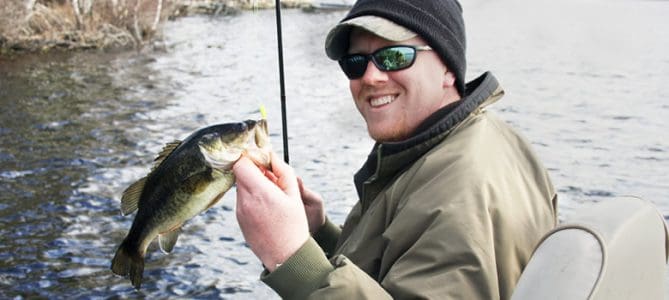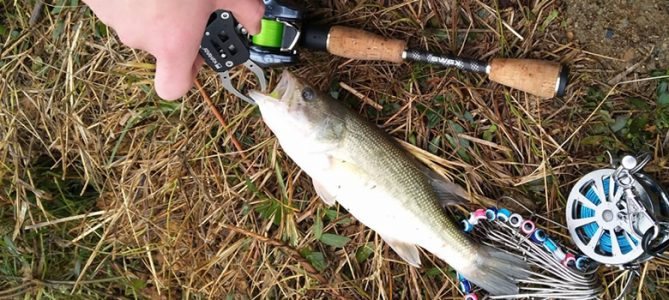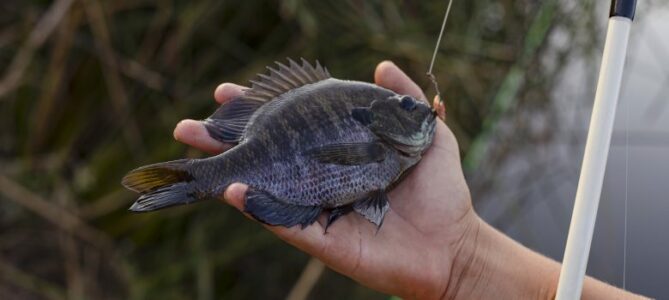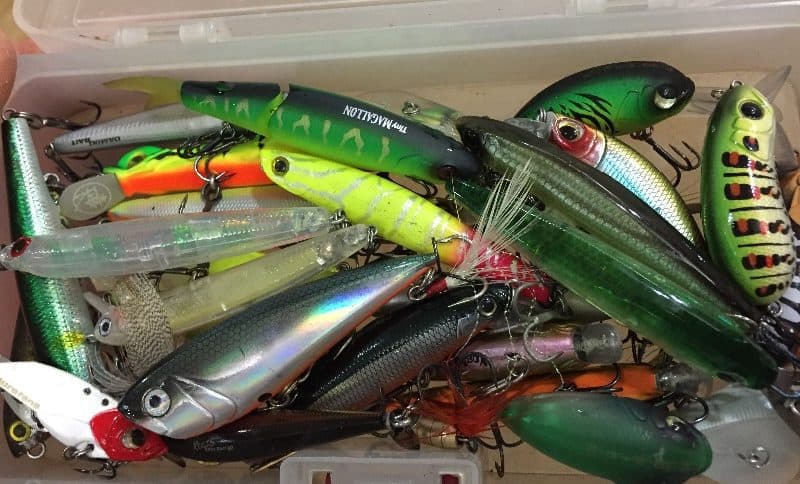If you buy via a link on this page, we may receive a commission, at no extra cost to you.Learn more
I wanted to start learning about fishing for my upcoming vacation. In order to fish productively, I started looking for quality equipment, including fishing poles, bait, and tackle boxes. I came across some information on wacky rigs and wanted to know how they could improve my experience.
What is a Wacky Rig for Fishing? A wacky rig is both a technique and a setup used on difficult fishing days. It can help you catch fish in compromised fishing situations or when dealing with skeptical fish. The unusual placement of the fake worm, a small hook helps create a more natural movement in the water.
This seems like a simple technique; however, there are many details involved in the process. You must get the right hooks and lures to accomplish the task. Now that you know what a wacky rig is read on to find out how to perfect the technique to snare that bass.
The Technique of the Wacky Rig

The wacky rig technique looks easy. You must first prepare with the proper equipment, however. Once you have the right hooks, lures, and weights, you can set out on your adventure. The main part of the technique is the proper placement of the lure on the hook. You must place the hook in the middle of the worm instead on one end.
Skittish fish may not respond well to a worm lure that is hanging straight down in the water. This only allows movement on one end of the worm. This is not very natural and may deter some fish.
The wacky rig method allows you to fish more productively on difficult days. Barometric pressure, water temperature, and light in the water can all affect your fishing experience. The wacky rig will allow you to keep the bait in the zone longer. You don’t have to make the bait dance; it does that all on its own.
The Equipment for Wacky Rigs
You don’t need a whole lot of special gear for a good wacky rig. You just need some variations of the basics:
- Lures
- Lines
- Weight
- Rod
Hooks
There are many sizes of hooks used for fishing. This is due to the varying sizes of fish. You must get a good hold on the fish to reel it in. When you use the whacky rig technique, however, you must use a small hook.
The purpose of a wacky rig is to make your equipment less noticeable to the fish. The main hooks you need to avoid for this method are the Carolina rig and Texas rig. When you first set up your tackle box, purchase a variety of hooks so you are prepared for different situations.
Lures
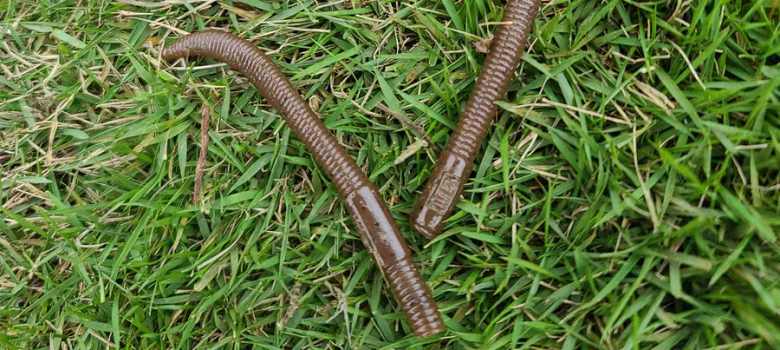
You generally use a 4-6-inch soft plastic worm lure for a wacky rig. They should be the same size in diameter from head to tail. Look for stick worms. They are heavier than other lures, making their movement more realistic.
You can use tapered worms if you do not have access to stick worms. You may not have as much success, however. Sometimes baits that look like small fish or crayfish are used, as well.
Line
The fishing line is another item you need to adjust for a wacky rig. You may have a thick line to support large fish. A proper wacky rig, however, depends on line invisibility. Trade in your hefty line for a lighter version.
Try to stay in the 6-10-pound range for line weight.
You also need to watch your line closely for signs of a bite. You cannot depend on the movement of your rod when using a wacky rig. The worm moves as the loose line is falling deep into the water. Bites may happen before your line is straight enough to move your rod.
Weights
Weights are necessary; however, they also need to remain discreet. Both nail and ring weights work for a wacky rig. You must insert nail weights through the head of the worm. They help to change the movement of the worm and allow you to fish in deeper water.
You can purchase nail weights specifically for a wacky rig setup; however, common nails work fine. With proper weight, your lure should reach depths up to 40 feet.
Ring weights are convenient, as you can hook the weight and worm at the same time. Either type of weight allows for good depth. Nail weights stay out of sight, however.
Fishing Rod
If you are already out on the water and need to switch to a wacky rig, you can use any fishing rod. There are simply some advantages to both long and short rods. You may also have a personal preference.
A long fishing rod is good if you want to cast further out. Most people find they can aim better with a shorter one, however. If the fish are picky or elusive, either one of these features may help.
How to Setup a Wacky Rig
Wacky rigs are among the easiest rigs to make. Plus, it is very effective against any fish, especially bass. Thus, it is an ability that any angler should have.
There are two ways of making a wacky rig. Both are equally effective. The main difference between them is that one method enhances worm life. So, let’s start with the first approach.
Method 1
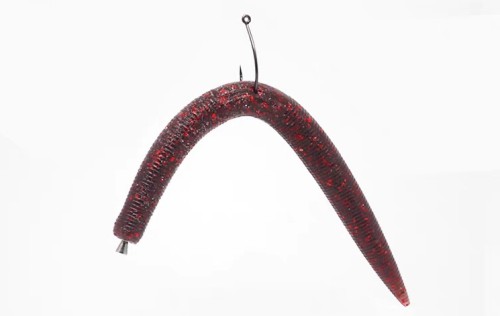
A fishing line, plastic worm, and a hook are the only things that you’ll need for this rigging method.
- First, fix the hook to the fishing line or leader if you are using one. We recommend using the Palomar knot.
- Now, grab the worm by the middle and giggle it a bit. See how it moves. Does it move somewhat the same on both sides? If not, try to find the balance.
- Then, grab the hook and poke the worm with it. The bard has to go all the way through it. There are ways of doing this.
All that is left is to cast the rig and wait. The next approach has a few extra steps. But it is not complicated at all.
Method 2
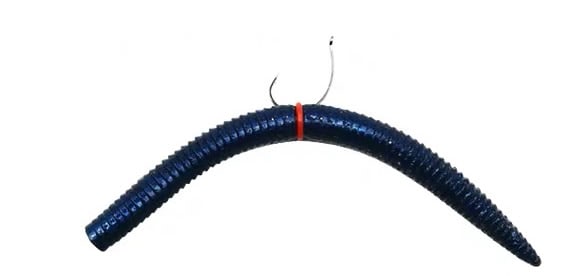
We will need the same items from the previous method plus an o-ring and o-ring tool. Yes, we know what you are thinking. What in god’s grace is an o-ring tool? These are little plastic things that look like the lower section of a pen.
It has two parts: The upper, where the worm goes, which is thicker, and the lower section where you place the o-rings.
- Again, secure the hook to the fishing line
- Grab the worm and pass it through the o-ring tool.
- Now, grab an o-ring and start rolling it to the other end of the tool. The ring will stretch since the upper section of the tool is thicker. This will allow you to put the o-ring in the middle of the worm without breaking a sweat.
- Take the hook and pass it through the o-ring with or without poking the worm.
The main advantage of this method is that you can catch more fish with the same worm. It won’t tear as easily as with method 1. Thus, prolonging its life, and saving you a couple of bucks in the process.
Wacky Rigs Variables
Although there are only two methods to make a wacky rig, there are a couple of things that you can add to the rig. For example, you can use a regular hook or one with a weed guard. Naturally, if you are fishing on waters with a lot of weeds, the former hook is the best option.
Similarly, you can add weight to the rig if you want the worm to sink faster. We recommend using a nail sinker for this. You simply stick it inside the worm, and that’s all. Another alternative is to use an o-ring with added weight.
We don’t recommend using conventional sinkers as they are very disruptive. Keep in mind that the worm has to look as natural as possible. A bullet sinker won’t do you any good.
Technique and Other Aspects of the Wacky Rig
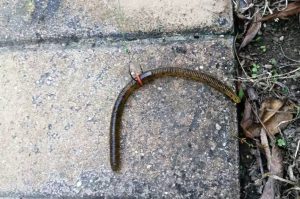
You’ve got your gear and your boat set up in the right spot. Now, it’s time to consider the other factors of the wacky rig setup.
Movement
The purpose of a fishing lure is to mimic the movement of a natural food source. If you encounter selective fish, your regular rig may not work. Centering a worm on the hook allows both ends to move. As the bait works its way into deeper water, it moves more like a live worm.
If you are not attracting fish once the line reaches maximum depth, pull the line up a little to make the worm move. You can also shake the line or reel it in and start over.
The Fish
You need to adjust your expectations for fishing with a wacky rig. The smaller hook and bait allow a variety of fish to bite. You may end up with a collection of smaller fish instead of large ones.
You can catch large fish with a wacky rig, however, expect some variety. Fishing in difficult conditions may result in fewer fish or smaller fish, but you can still enjoy the day out on the water. You can catch the “big one” another day.
Climate
A wacky rig may not help much in the depths of winter. You cannot control the slow movement of fish in cold water. Some fish are acclimated to a colder climate, but your choices decrease during the cold months.
If you go out after a storm, your wacky rig may not work as well, either. The worm is less visible in cloudy water. Some days are simply not conducive to fishing, even with the best equipment.
Location
A wacky rig can work well in a variety of environments, making it an excellent choice if you are having problems. Give it a try in areas with heavy vegetation, as well as in open water.
Check the reputation of any area you plan to visit. Some places are well-known for a high population of fish. You may have great luck in spawning areas, too. Do your research and ask locals if you are visiting a new area.
Variation
You do not have to adhere to every rule of wacky rigging. Find a variation that works for you. You might be out on a boat an decide to use a wacky rig at the last minute. Use what you have in your tackle box.
You may have a stick worm, but larger hooks. Go ahead and pierce the worm in whacky rig fashion. There is no reason to give up on a fun fishing day because you are missing a few pieces of the setup.
In Conclusion
It is a lot of fun to try out different rigs when learning to fish. The best way to learn is to try new things. You can also visit new places to gain more experience. The wacky rig technique is easy to learn but takes time to master. You need minimal equipment, ample time and a fisherman’s patience.
When you stock your tackle box, add the necessary items. This way they are available if you are ever in a difficult fishing situation.

